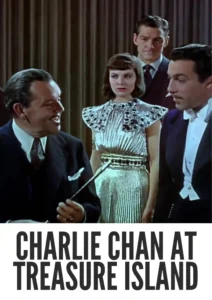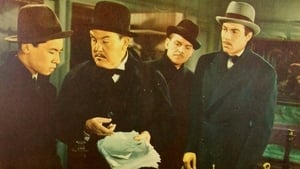Contact: info@alwanfilm.com
Video Sources 0 Views
- Charlie Chan at Treasure Island


Synopsis
Table of Contents
ToggleReview: Charlie Chan at Treasure Island 1939 Colorized – A Captivating Mystery Unfolds in Vivid Color

Introduction
“Charlie Chan at Treasure Island” (1939) invites audiences into the enigmatic world of detective Charlie Chan as he unravels a thrilling mystery set against the backdrop of San Francisco’s iconic Treasure Island. In this review, we’ll explore the significance of this early colored film, its impact on the mystery genre, and the enduring charm of its titular character.
Check The Full Colorized Movies List
Check Our Colorized Movies Trailer Channel
Understanding Charlie Chan at Treasure Island 1939 Colorized: Director, Cast, and Genre
Directed by Norman Foster, “Charlie Chan at Treasure Island” (1939) exemplifies the director’s adeptness at crafting suspenseful narratives that keep audiences on the edge of their seats. The film features Sidney Toler in the iconic role of Charlie Chan, whose calm demeanor and sharp intellect make him a formidable detective. Supported by a talented ensemble cast, including Cesar Romero and Pauline Moore, Toler brings the character of Chan to life with wit, charm, and a keen eye for detail. Blending elements of mystery, suspense, and humor, “Charlie Chan at Treasure Island” (1939) offers audiences a thrilling ride through the shadowy underworld of San Francisco.
Exploring the World of Charlie Chan at Treasure Island 1939 Colorized: Plot and Characters
At its core, “Charlie Chan at Treasure Island” (1939) follows the eponymous detective as he investigates a series of mysterious deaths at a magic show on Treasure Island. Along the way, he encounters a colorful cast of characters, from eccentric magicians to cunning criminals, each with their own secrets and motives. As Chan delves deeper into the case, he uncovers a web of deception and intrigue that threatens to unravel the fabric of society itself. With its twists and turns, “Charlie Chan at Treasure Island” (1939) keeps audiences guessing until the very end, proving that when it comes to solving crimes, there’s no one quite like Charlie Chan.
The Art of Film Colorization
Film colorization has long been a controversial topic in the world of cinema, with purists arguing that it compromises the artistic integrity of classic films. However, when done tastefully and with respect for the original work, colorization can breathe new life into beloved movies, offering viewers a fresh perspective on familiar stories. In the case of “Charlie Chan at Treasure Island” (1939), the decision to release the film in a colorized format adds an extra layer of depth and visual richness to the atmospheric world of San Francisco.
Early Colored Films: A Brief History
The history of colored films stretches back to the early days of cinema, with filmmakers experimenting with various techniques to add color to their creations. From hand-painted frames to early Technicolor processes, the evolution of colored film has been marked by innovation and experimentation. As technology has advanced, so too has the art of colorization, with modern digital techniques offering filmmakers unprecedented control over the color palette of their films.
Charlie Chan at Treasure Island and Its Early Colored Version
The decision to release “Charlie Chan at Treasure Island” (1939) in a colorized format was met with both anticipation and skepticism. While some welcomed the opportunity to experience the film in vibrant color, others expressed concerns about the potential impact on its visual aesthetic. Nevertheless, the early colored version of “Charlie Chan at Treasure Island” (1939) offers audiences a fresh perspective on the classic mystery, enhancing its immersive qualities and bringing its richly detailed world to life in stunning detail.
The Debate Over Film Colorization
The debate over film colorization is a complex and nuanced issue, with passionate arguments on both sides of the divide. Proponents argue that colorization revitalizes classic movies for modern audiences, breathing new life into timeless stories and introducing them to a new generation of viewers. Detractors, on the other hand, maintain that colorization detracts from the authenticity of the original work, altering the director’s artistic intent and diminishing the historical significance of the film.
Examining Charlie Chan at Treasure Island as an Early Colored Film
As with any colorized classic, the impact of colorization on “Charlie Chan at Treasure Island” (1939) is a matter of personal interpretation. Some may argue that it enhances the film’s visual appeal and immerses viewers in its world, while others may feel that it detracts from the stark beauty of the original black and white version. Regardless of one’s stance on the issue, there’s no denying the enduring power of “Charlie Chan at Treasure Island” (1939) as a gripping mystery that continues to captivate audiences with its clever plotting and charismatic characters.
Influence and Legacy: Charlie Chan at Treasure Island 1939 Colorized’s Impact on Cinema
“Charlie Chan at Treasure Island” (1939) has left an indelible mark on the world of cinema, inspiring countless filmmakers and captivating audiences with its timeless tale of mystery and intrigue. From its atmospheric setting to its memorable characters, the film continues to resonate with viewers of all ages, reaffirming its status as a beloved classic of the mystery genre.
Director’s Cinematic Legacy: Beyond Charlie Chan at Treasure Island 1939 Colorized
Norman Foster’s influence extends far beyond “Charlie Chan at Treasure Island” (1939), with a diverse body of work that spans multiple genres and styles. From his early days as a silent film actor to his later career as a director and screenwriter, Foster’s contributions to the world of cinema are as varied as they are impressive. Through his groundbreaking work, Foster has left an indelible imprint on the world of cinema, inspiring generations of filmmakers to follow in his footsteps.
Themes Explored in Charlie Chan at Treasure Island 1939 Colorized
“Charlie Chan at Treasure Island” (1939) explores a myriad of themes, from the nature of truth and deception to the power of perseverance and determination. Through its richly drawn characters and intricate plotting, the film invites viewers to ponder the complexities of human nature and the eternal struggle between good and evil. As audiences immerse themselves in the world of Charlie Chan, they are reminded of the timeless truths that bind us together as human beings and the enduring power of justice to triumph over adversity.
Reception and Controversy Surrounding Charlie Chan at Treasure Island 1939 Colorized
Upon its release, “Charlie Chan at Treasure Island” (1939) received widespread critical acclaim, with many praising its clever plotting, atmospheric setting, and memorable performances. However, the decision to release the film in a colorized format sparked debate among purists, reigniting the age-old discussion surrounding film preservation and artistic integrity. Despite the controversy, “Charlie Chan at Treasure Island” (1939) remains a beloved classic that continues to captivate audiences with its timeless tale of mystery and intrigue.
Where to Watch Charlie Chan at Treasure Island 1939 ColorizedOnline
For those eager to experience the timeless magic of “Charlie Chan at Treasure Island” (1939), the film is readily available on popular streaming platforms such as Netflix, Amazon Prime, and Hulu. Whether you choose to watch it in its original black and white format or the early colored version, “Charlie Chan at Treasure Island” (1939) promises to transport you to a world of mystery and adventure, where danger lurks around every corner and justice is always within reach.
FAQs About Charlie Chan at Treasure Island 1939 Colorized
Q: Is “Charlie Chan at Treasure Island” (1939) based on a true story? A: No, “Charlie Chan at Treasure Island” (1939) is a fictional mystery that draws inspiration from the classic detective novels of the era.
Q: Who are the main actors in “Charlie Chan at Treasure Island” (1939)? A: “Charlie Chan at Treasure Island” (1939) features Sidney Toler in the iconic role of Charlie Chan, alongside a talented ensemble cast that includes Cesar Romero and Pauline Moore.
Q: What awards did “Charlie Chan at Treasure Island” (1939) win? A: While “Charlie Chan at Treasure Island” (1939) did not win any major awards, it remains a beloved classic of the mystery genre, praised for its clever plotting and memorable characters.
Q: Why was “Charlie Chan at Treasure Island” (1939) released in a colorized format? A: The decision to release “Charlie Chan at Treasure Island” (1939) in color was made to introduce the film to a new generation of viewers and enhance its visual appeal for modern audiences. While the choice to colorize the film sparked debate among purists, it ultimately allowed “Charlie Chan at Treasure Island” (1939) to reach a wider audience and ensure its continued relevance in the annals of cinematic history.
Conclusion
As we reflect on the enduring legacy of “Charlie Chan at Treasure Island” (1939), let us celebrate its status as a timeless classic that continues to captivate audiences with its thrilling mystery, memorable characters, and breathtaking cinematography. Whether viewed in its original black and white format or the early colored version, “Charlie Chan at Treasure Island” (1939) remains a shining example of the power of cinema to entertain, inspire, and intrigue.











